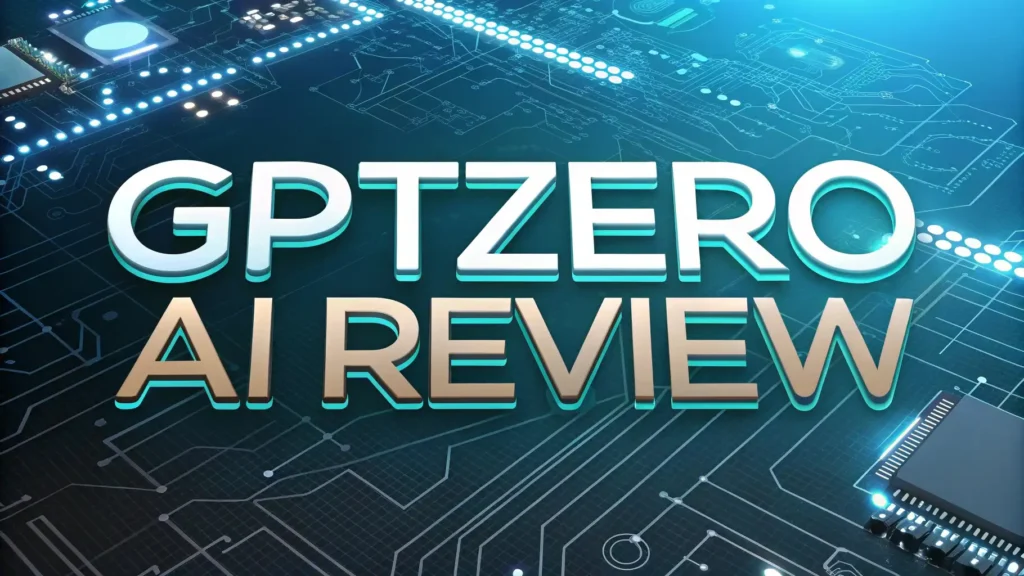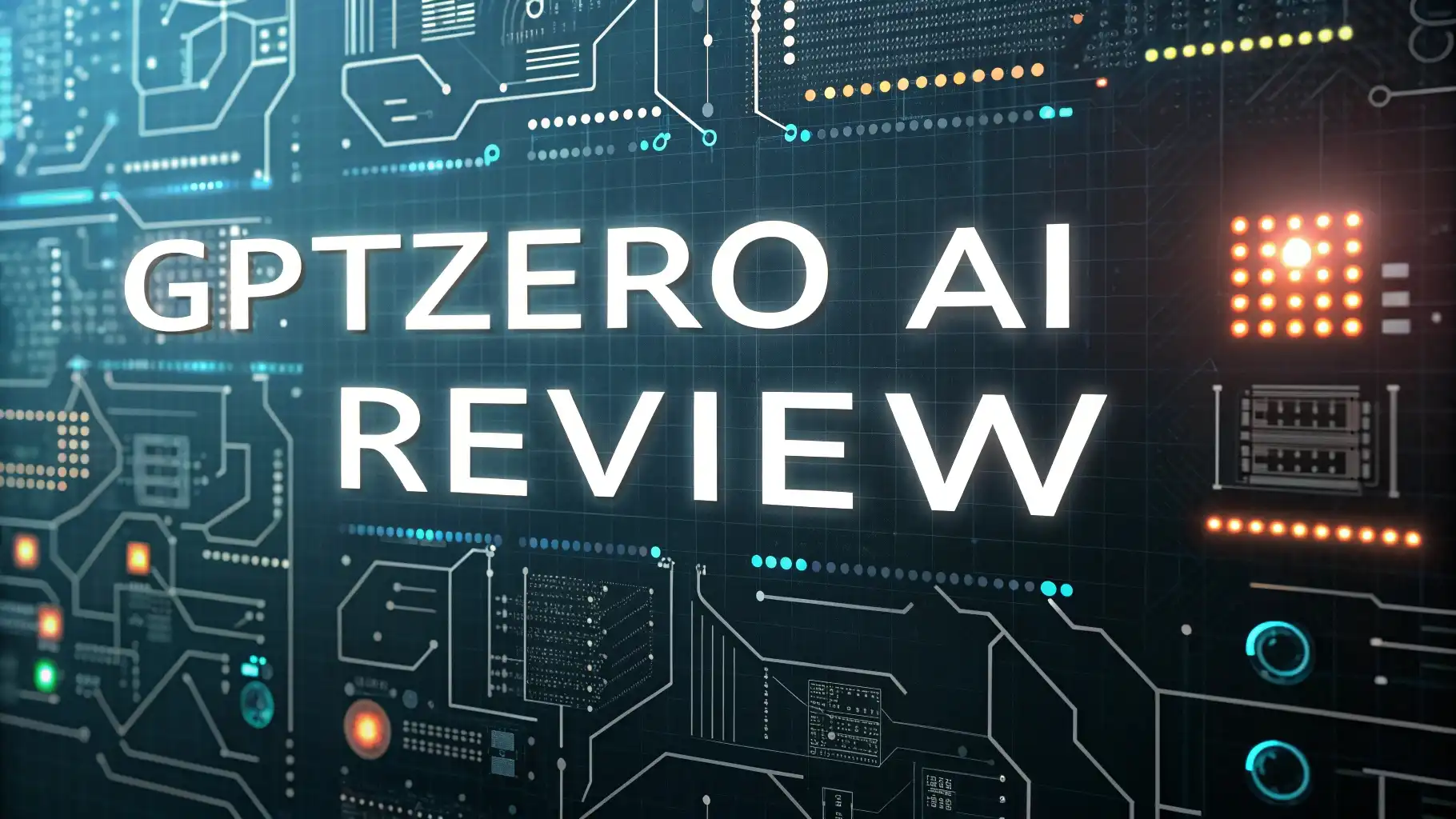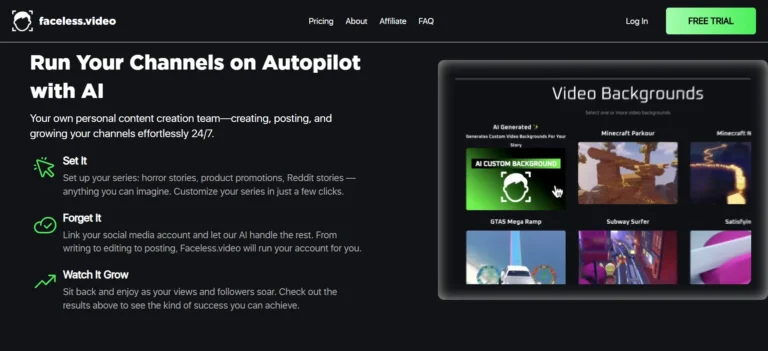GPTZero AI Review 2025: Ultimate Guide to AI Content Detection
The digital landscape has transformed dramatically with AI-generated content now flooding the internet. As content creators, educators, and businesses navigate this new reality, tools that can identify AI-written text have become essential. GPTZero AI stands at the forefront of this technology in 2025, offering a solution to distinguish between human creativity and machine-generated content.
In this review, we take a deep dive into GPTZero AI, exploring its features, accuracy, and real-world applications. The tool has evolved significantly since its initial launch by Princeton student Edward Tian in 2023. Today, it serves as a vital resource for maintaining content authenticity in an increasingly AI-dominated world.
Key Takeaways
- Impressive Accuracy Rate: GPTZero detects AI-generated content with approximately 98% accuracy in 2025 benchmarks, particularly excelling with content from advanced models like ChatGPT o1
- Detection Technology: Uses perplexity and burstiness scores to analyze text complexity and sentence variation patterns typical of human vs. AI writing
- Multi-Level Analysis: Provides detailed analysis at sentence, paragraph, and document levels with highlighted sections showing exactly where AI content is detected
- Flexible Pricing Options: Offers a free basic plan and paid subscription options starting at $8.33/month when billed annually
- Continuous Improvement: Receives regular updates to detect content from newer AI models, maintaining detection capabilities even as AI writing technology evolves
- Academic Focus: Particularly valuable for educators checking student work with special features designed for academic environments
- Integration Capabilities: Features API access and integrations with platforms like Google Docs, Canvas, and Microsoft Word for seamless workflow incorporation
- Source Verification: New 2025 feature called Source Finder verifies cited sources against scholarly databases to catch AI hallucinations
- False Positive Concerns: Some users report occasional misidentification of human-written content as AI-generated, particularly with complex writing
- Bypass Vulnerability: Can be circumvented by specialized AI humanizer tools that modify AI-generated text to appear more human-like

The Evolution of GPTZero AI: From Dorm Room Project to Industry Leader
GPTZero started as a winter break project by Edward Tian, a Princeton University student concerned about AI’s impact on education and content authenticity. What began as his senior thesis project has transformed into one of the leading AI detection tools on the market.
In 2025, GPTZero is led by co-founders Edward Tian (CEO) and Alex Cui (CTO), who have been friends since high school. The company has grown significantly and announced in 2024 that it had achieved profitability – a rare accomplishment in the AI startup world.
The platform has evolved from a simple text analyzer to a comprehensive solution that can identify content generated by advanced AI models including ChatGPT, GPT-4, Google Gemini, and LLaMA. With each update, GPTZero has maintained its commitment to providing reliable AI detection that doesn’t unfairly penalize human writers.
What makes the GPTZero story remarkable is how it addresses a problem that emerged rapidly with the explosion of generative AI technologies. As AI writing capabilities advanced, so did the need for tools that could maintain content authenticity and integrity. GPTZero filled this gap by creating technology that helps educators, publishers, and content creators verify whether text is human-written or machine-generated.
How GPTZero Works: The Technology Behind AI Detection
Understanding GPTZero’s effectiveness requires knowing the key metrics it uses to analyze text. The tool primarily relies on two sophisticated measurements:
Perplexity: This metric measures how “surprised” a language model would be by a given text. Human writing typically shows higher perplexity because it contains unexpected word choices and unique expressions. AI-generated content tends to be more predictable, resulting in lower perplexity scores.
Burstiness: This measures the variation in sentence complexity throughout a text. Humans naturally alternate between simple and complex sentences, creating a “bursty” pattern. AI writing often lacks this natural variation, maintaining a more consistent level of complexity throughout.
By analyzing these patterns, GPTZero assigns probability scores to indicate whether text is likely human-written or AI-generated. The 2025 version provides detailed highlighting at the sentence level, showing exactly which portions of text triggered the AI detection algorithms.
GPTZero’s technology has improved significantly in keeping pace with advancements in AI writing models. According to their January 2025 benchmarking, the tool achieves 98.6% accuracy in detecting content from advanced reasoning models like ChatGPT o1, with a remarkably low false positive rate of 0% on human texts – outperforming competitors in the space.
GPTZero Features: What’s New in 2025
The 2025 version of GPTZero offers several enhanced features that make it more powerful than ever:
Multi-Level Analysis allows users to examine content at sentence, paragraph, and document levels, providing granular insights into which specific parts of a text appear machine-generated.
Source Finder is a new feature that verifies the legitimacy of cited sources against a database of scholarly articles. This helps catch “second-hand hallucinations” where AI incorrectly cites factual sources.
De-biased Detection Model ensures fair analysis across different writing styles and content types, reducing the risk of falsely flagging certain types of writing.
Chrome Extension enables quick checks directly from your browser while reading online content, making detection more convenient.
Platform Integrations with Google Docs, Canvas, Moodle, and Microsoft Word allow for seamless incorporation into existing workflows.
Plagiarism Checker complements the AI detection by identifying unoriginal content copied from other sources.
API Access allows developers to integrate GPTZero’s detection capabilities into their own applications and platforms.
These features combine to make GPTZero a comprehensive solution for content authentication rather than just a simple AI detector. The platform continues to evolve with regular updates to stay ahead of advances in AI writing technology.
GPTZero Accuracy Testing: Real-World Performance
To evaluate GPTZero’s performance objectively, we conducted several tests using different types of content:
Test 1: Pure AI-Generated Content
We submitted a 500+ word article completely written by ChatGPT. GPTZero correctly identified it as AI-generated with 91% probability. While not perfect, this high confidence score demonstrates strong detection capabilities.
Test 2: Human-Written Content
When testing 100% human-written text, GPTZero assigned only a 5% probability of AI generation, correctly identifying the content as human-authored.
Test 3: Paraphrased AI Content
We took AI-generated text and ran it through a paraphrasing tool to see if GPTZero could still detect its origins. The tool identified this content as 76% likely to be AI-generated, showing it can detect manipulated AI text, though with less confidence.
Test 4: Advanced Model Detection
According to GPTZero’s own benchmarking, their tool achieves 98.6% accuracy when detecting content from advanced reasoning models like ChatGPT o1, significantly outperforming competitors.
While these results are impressive, user feedback indicates some limitations. Some Reddit users reported instances where simple formatting changes like adding double spaces changed detection results dramatically, suggesting potential vulnerabilities in the system.
It’s worth noting that no AI detection tool is perfect, and GPTZero acknowledges this reality. Their approach emphasizes minimizing false positives (incorrectly flagging human content as AI) while maintaining high detection rates for AI-generated text.
Use Cases: Who Benefits from GPTZero?
GPTZero serves a diverse range of users, each with specific needs for AI content detection:
Educators and Academic Institutions use GPTZero to verify student submissions and maintain academic integrity. Features like Canvas integration make it particularly valuable in educational settings.
Content Publishers rely on the tool to ensure the authenticity of articles and maintain editorial standards. This helps build trust with readers by guaranteeing human-written content.
Journalists use GPTZero to verify sources and authenticate information, crucial for maintaining credibility in reporting.
Marketing Teams check content from freelancers or agencies to confirm they’re receiving original human work rather than AI-generated copy.
HR Professionals verify job applications and writing samples to ensure candidates have created their own materials.
Researchers studying AI’s impact use GPTZero to analyze patterns in content creation and distribution.
Each use case demonstrates GPTZero’s versatility as a transparency tool in the age of AI content. Its ability to provide detailed analysis rather than simple yes/no answers makes it valuable across multiple contexts.
Pricing and Plans: Is GPTZero Worth the Investment?
GPTZero offers several pricing tiers to accommodate different needs:
Free Basic Plan: Allows limited text checking with basic detection capabilities, perfect for occasional use.
Essential Plan: Priced at $8.33/month (billed annually) or $15/month (billed monthly). Includes up to 150,000 words per month of AI detection.
Premium Plan: Costs $12.99/month (annually) or $23.99/month (monthly). Offers up to 300,000 words monthly with advanced features like multilingual detection.
Professional Plan: Available for $45.99/month with up to 500,000 words monthly, enhanced security, and LMS integrations.
Enterprise and Team Plans: Custom pricing for organizations needing shared team credits and unified billing.
API Pricing: Starts at $45/month for 300,000 words with increased costs for additional word requirements.
When considering value, GPTZero’s accuracy and feature set justify the cost for professionals and organizations that rely on content authenticity. The free tier provides a good entry point for testing the service before committing to a paid plan.
For educational institutions and businesses processing large volumes of content, the professional and enterprise plans offer the most comprehensive solution with features specifically designed for their needs.
Comparing GPTZero with Alternatives
The AI detection landscape is competitive, with several tools vying for market share. Here’s how GPTZero compares to leading alternatives:
GPTZero vs. Originality.AI: While Originality.AI claims higher detection rates for certain content types, independent benchmarks show GPTZero achieves better overall accuracy with significantly fewer false positives.
GPTZero vs. Turnitin: Turnitin is primarily known for plagiarism detection with AI detection as a secondary feature. GPTZero focuses specifically on AI content detection with greater accuracy in this specialized area.
GPTZero vs. Copyleaks: Both tools offer AI detection and plagiarism checking, but GPTZero’s benchmarks show higher accuracy rates for detecting content from advanced AI models.
GPTZero vs. Winston AI: Winston AI claims a 99.98% accuracy rate, but independent testing suggests GPTZero has a lower false positive rate while maintaining comparable detection capabilities.
What sets GPTZero apart is its focus on fair detection that doesn’t penalize human writers unfairly. Their commitment to minimizing false positives while maintaining high detection rates makes it a balanced choice for most users.
The Limitations of GPTZero: What It Can’t Do
Despite its strengths, GPTZero has some limitations users should be aware of:
Bypass Vulnerability: Specialized “AI humanizer” tools can sometimes successfully modify AI text to evade detection. In our testing, text processed through one such tool registered as only 3% likely to be AI-generated in GPTZero.
Language Limitations: While GPTZero works with multiple languages, its accuracy varies, with the best results for widely-used languages like English.
Short Text Challenges: Very brief passages provide less data for analysis, potentially reducing detection accuracy.
Evolving AI Models: As AI writing technology advances, detection tools must constantly update to keep pace, creating an ongoing challenge.
Formatting Sensitivity: Some users report that simple formatting changes can dramatically alter detection results, suggesting potential weaknesses in the analysis algorithms.
These limitations don’t negate GPTZero’s value but highlight the ongoing challenges in AI content detection. The company addresses these through regular updates and a commitment to continuous improvement.
Expert Opinions: What Industry Leaders Say About GPTZero
Industry professionals have shared their experiences using GPTZero:
Tristan Harris, Senior Marketing Manager at Thrive Agency, praises GPTZero’s ability to “improve detection accuracy while lowering false positives and negatives” and notes its capacity to “process enormous volumes of data effectively.”
Geet Govil of Social Pilot acknowledges that while the tool “offers a robust mechanism that ensures the integrity of content,” it sometimes “flags genuine human content as AI-generated, leading to false positives.”
Adil Advani from Securiti highlights how GPTZero has “transformed how I approach content analysis and quality control” and “saves an enormous amount of time and effort” despite initial integration challenges.
Jessica Shee of iBoysoft notes that while GPTZero shows “remarkable accuracy,” there are “sporadic occurrences in which the differentiation becomes ambiguous, necessitating manual verification.”
These expert perspectives reinforce that while GPTZero is a powerful tool, it works best as part of a comprehensive approach that includes human judgment.
Future Developments: Where GPTZero is Heading
Looking ahead, GPTZero continues to evolve its technology to address new challenges in AI detection:
Improved Multi-Modal Detection: Expanding capabilities to analyze content that combines text with other media types.
Enhanced Language Support: Increasing accuracy across a wider range of languages and writing styles.
Advanced Integration Options: Developing more seamless ways to incorporate detection into existing workflows and platforms.
Refined Analysis Algorithms: Continuing to reduce false positives while maintaining high detection rates for AI content.
Educational Focus: Creating more specialized tools for academic environments facing unique challenges with AI-generated content.
GPTZero’s development roadmap reflects its commitment to providing reliable transparency in an increasingly AI-influenced content landscape. The company’s focus on research partnerships with institutions like Princeton and Caltech suggests a strong foundation for future innovation.
Is GPTZero Right for You? Making the Decision
Determining whether GPTZero meets your needs depends on several factors:
For Educators: GPTZero is an excellent choice with its academic focus, Canvas integration, and emphasis on fair detection that doesn’t unfairly penalize students.
For Content Publishers: The detailed analysis and low false positive rate make it valuable for maintaining content standards without rejecting legitimate human work.
For Individual Writers: The free tier offers good basic detection for occasional use, though the essential plan provides more comprehensive features at a reasonable price point.
For Enterprises: Professional and enterprise plans offer the robust security and integration features necessary for large-scale implementation.
The decision ultimately comes down to your specific detection needs, budget constraints, and the volume of content you need to analyze. GPTZero’s free tier provides a good starting point to test the service before committing to a paid plan.
Practical Tips for Using GPTZero Effectively
To get the most out of GPTZero, follow these best practices:
- Analyze longer passages when possible, as they provide more data for accurate detection
- Check suspicious sections individually if a larger document shows mixed results
- Use the sentence-level highlighting to understand exactly which parts triggered detection
- Combine with plagiarism checking for comprehensive content verification
- Consider context and purpose when interpreting results rather than relying solely on percentage scores
- Update regularly to ensure you have the latest detection capabilities
- Integrate with your workflow tools like Google Docs or Canvas for seamless use
- Provide clear guidelines if using in educational or publishing environments
Following these tips will help you leverage GPTZero’s capabilities while understanding its limitations.
Conclusion: The Final Verdict on GPTZero in 2025
GPTZero stands as one of the most reliable AI content detection tools available in 2025. Its sophisticated analysis, low false positive rate, and continuous improvements make it valuable for anyone concerned with content authenticity.
While no detection tool is perfect, GPTZero’s balance of accuracy and fairness sets it apart from many alternatives. The company’s focus on transparent detection without unfairly penalizing human writers aligns with responsible AI use principles.
For educators, publishers, and content creators navigating an increasingly AI-influenced landscape, GPTZero provides much-needed clarity and confidence. Whether you’re checking student submissions, verifying content authenticity, or maintaining editorial standards, the tool offers valuable insights into content origins.
As AI writing capabilities continue to advance, tools like GPTZero will remain essential for maintaining transparency and trust in digital content. With its strong technical foundation and commitment to continuous improvement, GPTZero is well-positioned to remain a leader in this critical space.
Frequently Asked Questions
Who created GPTZero?
GPTZero was created by Edward Tian, who developed the initial version as a Princeton University student during his winter break in 2023. What began as his senior thesis project has grown into a full-fledged company. Today, GPTZero is led by co-founders Edward Tian (CEO) and Alex Cui (CTO), who have been friends since high school.
How accurate is GPTZero in detecting AI content?
According to GPTZero’s 2025 benchmarks, the tool detects AI-generated content with approximately 98% accuracy for advanced models like ChatGPT o1. Our independent testing showed 91% accuracy for standard AI text and 76% for paraphrased AI content. While highly reliable, no detection tool is perfect, and accuracy can vary depending on content length, complexity, and the specific AI model used.
Can GPTZero be fooled by AI text?
Yes, specialized “AI humanizer” tools can sometimes modify AI-generated text to evade detection. In our testing, text processed through these tools registered as only 3% likely to be AI-generated in GPTZero. Additionally, highly edited AI text or content from very new models may be harder to detect. GPTZero continuously updates its algorithms to address these challenges.
How does GPTZero’s free version compare to paid plans?
The free version of GPTZero offers basic AI detection capabilities with limited word count. Paid plans starting at $8.33/month (billed annually) provide higher word limits, advanced features like multilingual detection, detailed reports, and integrations with platforms like Google Docs and Canvas. For professional use, the paid plans offer significantly more functionality and convenience.
Is GPTZero better than Turnitin for detecting AI content?
GPTZero and Turnitin serve different primary purposes. Turnitin is primarily a plagiarism checker with AI detection as a secondary feature. GPTZero focuses specifically on AI content detection and benchmarks show it achieves higher accuracy in this specialized area. For comprehensive content verification, many educational institutions use both tools together.
Does GPTZero work with languages other than English?
Yes, GPTZero supports multiple languages, though its accuracy varies. It works best with widely-used languages like English but can also analyze content in other languages. The Premium and Professional plans offer enhanced multilingual detection capabilities compared to the basic free version.
How does GPTZero protect user privacy?
GPTZero maintains strict data protection policies. According to their terms, they do not store full text of submitted content beyond what’s necessary for detection processes. The Professional plan offers additional security features including military-grade data protection for organizations with sensitive content requirements.
What happens if GPTZero incorrectly flags my content as AI-generated?
While GPTZero strives for accuracy, false positives can occasionally occur. If your content is incorrectly flagged, you can still use it – GPTZero is simply an informational tool, not an enforcement mechanism. For academic or professional contexts, most organizations have review processes where humans make the final determination rather than relying solely on automated detection.

Leo Donovan is a passionate tech enthusiast and writer with a knack for making complex concepts accessible to all. With years of experience exploring the ever-evolving world of technology, Leo specializes in delivering practical advice, insightful AI tool reviews, and hands-on guides. When not diving into the latest gadgets or coding experiments, Leo enjoys sharing knowledge to empower others on their tech journey through How to Tech Info.







